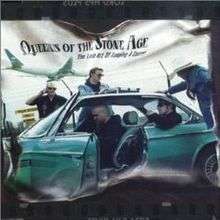The Lost Art of Keeping a Secret
| "The Lost Art of Keeping a Secret" | ||||
|---|---|---|---|---|
 Cover of European 7" and UK CD 1 | ||||
| Single by Queens of the Stone Age | ||||
| from the album Rated R | ||||
| Released | August 7, 2000 | |||
| Format | ||||
| Recorded | 1999-2000 | |||
| Genre | ||||
| Length | 3:36 | |||
| Label | Interscope | |||
| Songwriter(s) | ||||
| Producer(s) |
| |||
| Queens of the Stone Age singles chronology | ||||
| ||||
| Alternative covers | ||||
 Cover of UK CD 2 | ||||
"The Lost Art of Keeping a Secret" is the first single from Queens of the Stone Age's second album, Rated R. It was released in the summer of 2000 through Interscope Records in Europe as a standard single, and in the US as only a promotional one. The track became arguably the band's most recognizable and popular song at its time of release. Its music video received mild airplay on music television. It was also the only single from Rated R to get a chart position, reaching number 21 on the Mainstream Rock charts, number 36 on the Modern Rock charts and number 31 on the UK Singles Chart.
The song was featured in the films Sound City and Smokin' Aces 2: Assassins' Ball, the TV series Numbers, Nip/Tuck, Entourage and Daria, and in the video games Tony Hawk: Ride, Driver: San Francisco and Gran Turismo 5.
Track listings
All tracks by Joshua Homme and Nick Oliveri, except where noted.
Europe
- 7" 497 387-7
- CD 497 410-2
- "The Lost Art of Keeping a Secret" - 3:36
- "Ode to Clarissa" - 2:40
UK
- CD 1 497 391-2
- "The Lost Art of Keeping a Secret" - 3:36
- "Born to Hula" (Homme) - 5:52
- A re-record of the song previously released on the Gamma Ray EP and the Kyuss / Queens of the Stone Age split EP.
- "The Lost Art of Keeping a Secret" (CD-ROM Video) - 3:36
- CD 2 497 392-2
- "The Lost Art of Keeping a Secret" - 3:36
- "Ode to Clarissa" - 2:40
- "Monsters in the Parasol" (Live in Seattle) (Homme, Mario Lalli) - 3:32
Personnel
- Joshua Homme – Lead vocals, rhythm & lead guitar
- Nick Oliveri – Bass, backing vocals
- Nick Lucero – Drums
- Pete Stahl – Backing vocals
- Dave Catching – Electric piano
- Barrett Martin – Vibes
- Scott Mayo – Baritone sax
- Chris Goss – Noise piano
Charts
| Chart (2000) | Peak position |
|---|---|
| UK Singles (Official Charts Company)[1] | 31 |
| US Mainstream Rock (Billboard)[2] | 21 |
| US Alternative Songs (Billboard)[3] | 36 |
References
- ↑ "Queens of the Stone Age: Artist Chart History". Official Charts Company. Retrieved March 17, 2017.
- ↑ "Queens of the Stone Age Chart History (Mainstream Rock)". Billboard. Retrieved March 16, 2017.
- ↑ "Queens of the Stone Age Chart History (Alternative Songs)". Billboard. Retrieved March 16, 2017.
External links